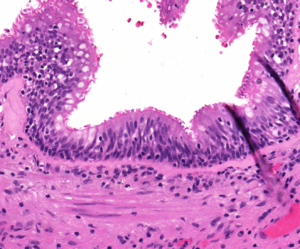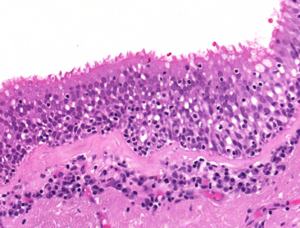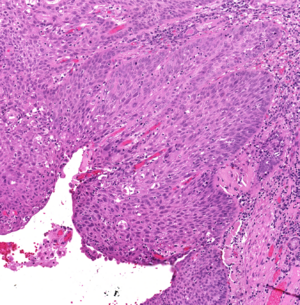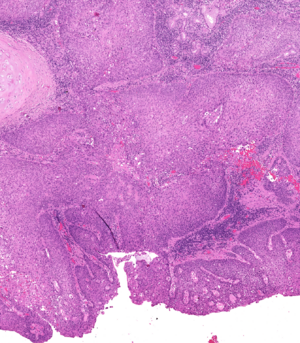50. Planocellular carcinoma of the lung: Difference between revisions
(Created page with "'''Staining''': HE '''Organ''': Bronchus '''Description''': We can see cartilage and respiratory epithelium, so we know that this is a bronchus. We can divide the slide into 5 “parts”: * 1 shows normal, healthy respiratory epithelium * 2 shows goblet cell hyperplasia and basal cell hyperplasia * 3 shows squamous cell metaplasia * 4 shows squamous cell dysplasia and carcinoma in situ * 5, which is the majority of the slide, shows the invasive carcinoma The carci...") |
No edit summary |
||
| Line 1: | Line 1: | ||
'''Staining''': HE | [[File:Squamous carcinoma of lung overview.png|thumb|Overview of the slide, with the 5 parts]]'''Staining''': HE | ||
'''Organ''': Bronchus | '''Organ''': Bronchus | ||
| Line 22: | Line 22: | ||
* Smoking | * Smoking | ||
[[File:Squamous carcinoma of lung part 1.png|thumb|From part 1. Shows normal, healthy respiratory epithelium.]]'''Theory''': | |||
'''Theory''': | |||
Squamous cell carcinoma in the lung usually occurs centrally, around the hilum. It shows symptoms earlier than adenocarcinomas and large cell carcinomas, which grow peripherally. However, also because of the central location is surgical removal of squamous cell carcinomas more difficult than for the peripheral-growing cancers. | Squamous cell carcinoma in the lung usually occurs centrally, around the hilum. It shows symptoms earlier than adenocarcinomas and large cell carcinomas, which grow peripherally. However, also because of the central location is surgical removal of squamous cell carcinomas more difficult than for the peripheral-growing cancers. | ||
| Line 30: | Line 29: | ||
It can metastasize into pericardium, mediastinum, aorta and even the heart. | It can metastasize into pericardium, mediastinum, aorta and even the heart. | ||
[[File:Squamous carcinoma of lung part 2.png|thumb|From part 2. Shows goblet cell and basal cell hyperplasia. Basal cells are the cells that are in contact with the basement membrane.|left]] | |||
[[File:Squamous carcinoma of lung part 3.png|thumb|From part 3. Shows the border between respiratory epithelium and squamous metaplasia (upper half of the slide). You can see that the squamous metaplasia doesn’t have kinocilia.]] | |||
[[File:Squamous carcinoma of lung part 2.png | [[File:Squamous carcinoma of lung part 4.png|thumb|From part 4. Shows squamous cell dysplasia and carcinoma in situ.|left]] | ||
[[File:Squamous carcinoma of lung part 3.png | [[File:Squamous carcinoma of lung part 5.png|thumb|From part 5. Shows how the cancer has spread even beyond the cartilage (upper left).]] | ||
[[File:Squamous carcinoma of lung part 4.png | [[File:Squamous carcinoma of lung pleomorphism.png|thumb|From part 5. Shows pleomorphism (anisocytosis, anisochromasia, anisonucleosis), mitotic figures and multinucleated giant cells.|left]] | ||
[[File:Squamous carcinoma of lung part 5.png | |||
[[File:Squamous carcinoma of lung pleomorphism.png | |||
[[Category:Pathology 1 - Histopathology slides]] | [[Category:Pathology 1 - Histopathology slides]] | ||
Revision as of 12:55, 5 July 2024

Staining: HE
Organ: Bronchus
Description:
We can see cartilage and respiratory epithelium, so we know that this is a bronchus.
We can divide the slide into 5 “parts”:
- 1 shows normal, healthy respiratory epithelium
- 2 shows goblet cell hyperplasia and basal cell hyperplasia
- 3 shows squamous cell metaplasia
- 4 shows squamous cell dysplasia and carcinoma in situ
- 5, which is the majority of the slide, shows the invasive carcinoma
The carcinoma cells show pleomorphism and mitotic figures and giant cells are present.
Diagnosis: Squamous cell lung carcinoma
Causes:
- Smoking

Theory:
Squamous cell carcinoma in the lung usually occurs centrally, around the hilum. It shows symptoms earlier than adenocarcinomas and large cell carcinomas, which grow peripherally. However, also because of the central location is surgical removal of squamous cell carcinomas more difficult than for the peripheral-growing cancers.
In this slide we can see several stages of cancer development, from hyperplasia to metaplasia to dysplasia to cancer.
It can metastasize into pericardium, mediastinum, aorta and even the heart.





